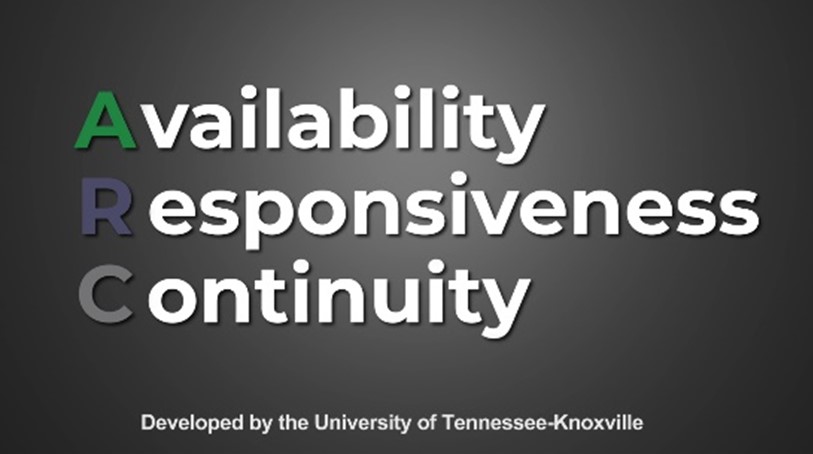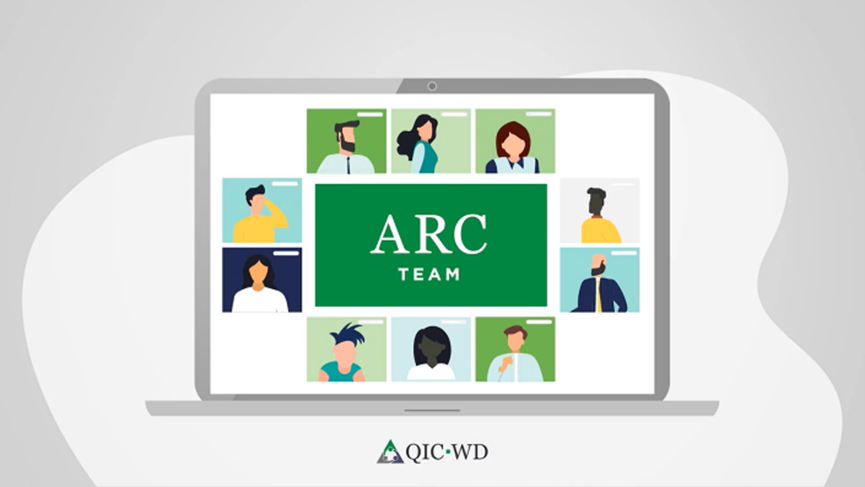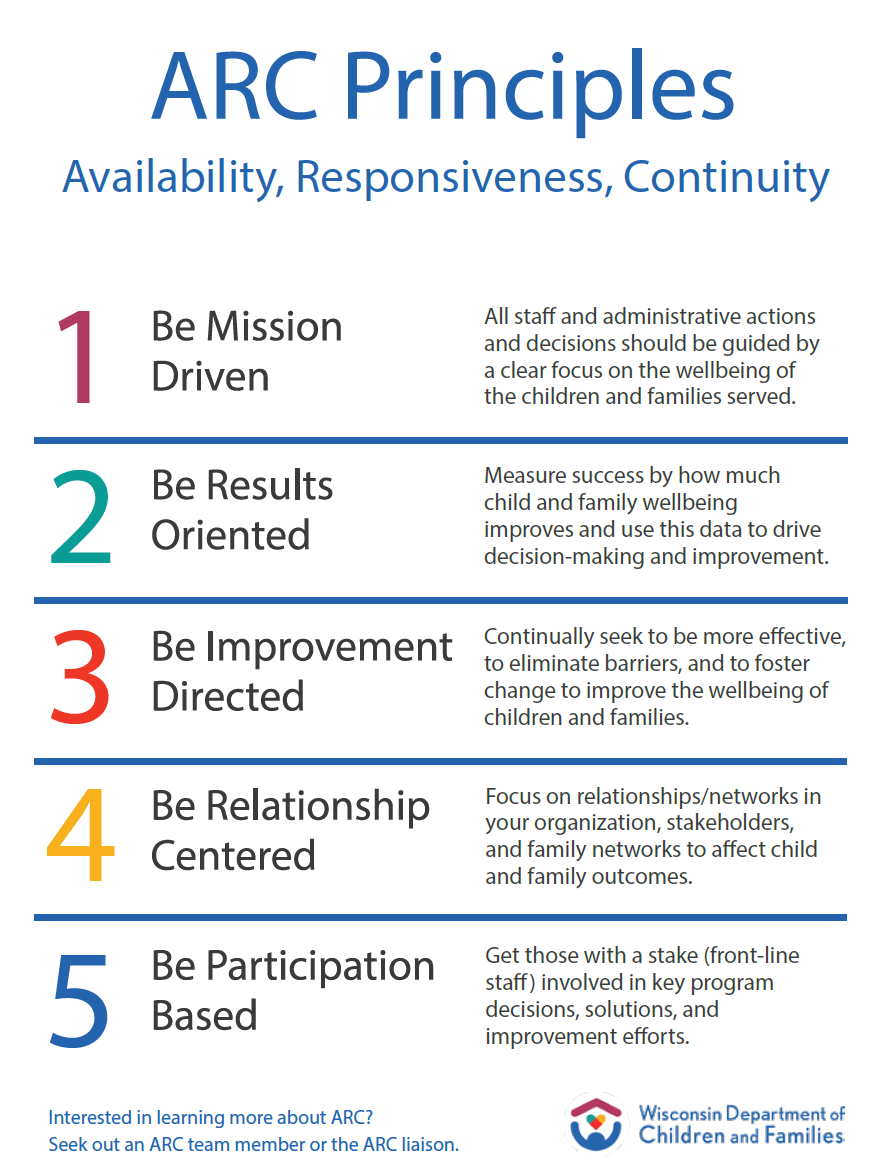Organizational Change Process
What is ARC and why was it selected?
ARC stands for availability, responsiveness, and continuity and is an organizational change process. It is aimed at improving the organizational culture and climate and the availability, responsiveness, and continuity of services provision in human service organizations. ARC involves three primary strategies:
- embedding five core principles of effective organizations into all aspects of organizational functioning;
- installing most (but not necessarily all) of 12 key organizational component tools and processes to improve services in accordance with the five principles; and
- building mental models and shared beliefs that support the successful application of ARC principles and components.
 ARC was selected as the intervention for The Division of Milwaukee Child Protective Services based on a needs assessment that included administration of the Organizational Social Context (OSC) Measure, used to assess organizational culture and climate. The survey results showed opportunities for improvement in both culture and climate, and ARC is designed to improve organizational culture and climate as defined and measured by the OSC. The project implementation team, consisting of frontline staff and leadership, selected ARC after a careful analysis of ARC and several other alternatives.
ARC was selected as the intervention for The Division of Milwaukee Child Protective Services based on a needs assessment that included administration of the Organizational Social Context (OSC) Measure, used to assess organizational culture and climate. The survey results showed opportunities for improvement in both culture and climate, and ARC is designed to improve organizational culture and climate as defined and measured by the OSC. The project implementation team, consisting of frontline staff and leadership, selected ARC after a careful analysis of ARC and several other alternatives.
What is the impact of ARC?
Several studies have demonstrated the effectiveness of ARC. More specifically, controlled studies have shown that ARC improves organizational culture and climate; employee morale, exploration of and adoption of evidence-based practices, and turnover; and youth outcomes (Glisson et al., 2006, 2010, 2012, 2013, 2016a, & 2016b; Williams et al., 2017). Most of the published research has been conducted in mental health settings, looking at mental health practitioners and delinquent or at-risk youth. Compared to agencies or programs that did not implement ARC, ARC-involved groups had (1) higher job satisfaction and organizational commitment, (2) better organizational climate (as indicated by lower role conflict and higher levels of personalization and sense of growth and advancement), (3) and organizational cultures that were more proficient and less rigid, centralized, and apathetic (Glisson et al., 2012, 2016b). In addition, clinicians who participated in ARC were more likely to explore the use of and implement evidence-based treatments with their clients (Glisson et al., 2016b; Williams et al., 2017). Finally, youth treated by clinicians that were involved in ARC had fewer problem behaviors and out-of-home placements (Glisson et al., 2010, 2013, 2016a).
Additionally, the effect of ARC applied within a child welfare and juvenile justice system using a randomized control trials design found that ARC improved four aspects of organizational climate (role conflict, role overload, emotional exhaustion, and depersonalization). Similarly, ARC reduced the probability of caseworker turnover by two-thirds (Glisson et al., 2006). Culture changes were not significant given the duration of the one-year intervention, and case practice and outcomes were not assessed. Previous correlational studies within child welfare by ARC developers, however, demonstrated relationships between higher climate scores with outcomes such as quality of services and improvement outcomes for children (Glisson & Hemmelgarn, 1998).
 How does ARC work?
How does ARC work?
Broadly speaking, the goal of the ARC process is to improve services through improvements in the organizational social context (i.e., culture and climate). These are “interpersonal networks of individuals characterized by norms, expectations, and shared perceptions that influence individual behavior” (Glisson & Williams, 2015, p. 508). Organizational social contexts are the focus of ARC because they are associated with a variety of important employee, organizational, and client outcomes, such as job satisfaction, attitudes toward evidence-based practice, turnover, provision of mental health treatment and child welfare services, and child and youth psychosocial functioning (e.g., Aarons et al., 2012; Aarons & Sawitzky, 2006; Glisson & Green, 2006; Glisson & Green, 2011; Glisson & Hemmelgarn, 1998).
To achieve changes in the organizational social context and service outcomes, the ARC process includes several primary strategies. One primary strategy is to embed five core principles into organizational functioning (being mission driven, results oriented, improvement directed, relationship centered, and participation based). Research has shown that improvements in youth outcomes are mediated by changes in enactment of these ARC principles (Glisson et al., 2016). In other words, adoption of the ARC principles is one of the mechanisms through which ARC improves service outcomes. Research has also shown that improvements in clinicians’ exploration and use of evidence-based treatments is mediated by changes in the proficiency dimension of organizational culture (i.e., norms and expectations that staff will be highly knowledgeable, skilled, and focused on client well-being). In other words, culture change is one of the mechanisms through which ARC improves evidence-based practice.
 What research gap is the QIC-WD addressing?
What research gap is the QIC-WD addressing?
Despite the many studies on ARC and organizational social contexts in organizations, there is still more to learn. ARC involves several strategies and components that are intended to have intermediate effects (e.g., improvement in psychological safety, teamwork, availability, responsiveness, and continuity) that are intended to lead to changes in culture, climate, services, and service outcomes. These strategies and components are in need of further examination, so as to identify the key components that are needed (or not needed) for maximal ARC efficiency and effectiveness (Glisson & Williams, 2015). While the overall impact of ARC on organizational culture and climate (as measured by the OSC) has been documented, there is less known about short- and moderate-term outcomes or process variables that impact these outcomes. In addition, there may be factors that enhance or compromise ARC’s effects, such as training satisfaction or leadership support. In a child welfare setting, research on ARC has involved a one-year ARC process, whereas in mental health settings, ARC has been implemented for as long as three years, with even longer follow-up periods. More time may allow for other long-term outcomes. The most common employee attitudinal outcomes assessed thus far are job satisfaction and organizational commitment, but there may be others that are affected by ARC as well, such as work engagement or perceived organizational support. Finally, though there have been several studies assessing clinician behavior and youth outcomes in mental health settings, as well as correlational effects of climate on quality of services and children’s outcomes in child welfare, no studies have examined child welfare case practice and outcomes in randomized control trials beyond turnover and improved climate outcomes.